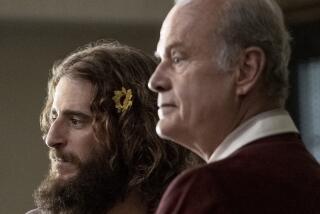Who’s in Trollope’s Corner? Britons Are Split Over Honoring Novelist
- Share via
LONDON — The dean of Westminster Abbey, the keeper of Poets’ Corner, faces a thorny question: Is there room for Anthony Trollope, the Victorian novelist?
Prime Minister John Major thinks there is, and some other big names in Britain’s Establishment agree.
But the Very Rev. Michael Mayne says the only literary advice he needs is his own.
“The abbey is very, very full and you have to be very, very sure that the person proposed is worthy of a permanent memorial,” says Mayne, who in his five years as dean has chosen memorials to John Clare and Edward Lear.
Clare, a self-educated 19th-Century farm laborer who wrote nature poems, was committed to an insane asylum at 40, believing himself to be either Napoleon or Lord Byron.
Lear, a Victorian landscape painter cum comic poet, wrote “The Book of Nonsense” and popularized the limerick.
Trollope satirized the Church of England--indeed, he said some sharp things about the abbey itself--in his six Barchester novels, beginning with “The Warden.”
He wrote more than 50 novels, grinding out 2,500 words every morning before going to work at the post office, where he devised the cylindrical post boxes seen all over Britain.
The American writer Henry James, who settled in England, called Trollope “the dullest Briton of them all.”
Mayne bears no such ill will and considers him a “very serious candidate.” But, he said, it is “unwise” of the Trollope Society, including the prime minister’s wife, Norma, to be “pressuring like mad.”
For 591 years, literary pilgrims have made a beeline for Poets’ Corner, the “first and still the most comprehensive attraction for the literary tourist,” according to Cambridge University historian Ian Ousby, author of “The Englishman’s England.”
The abbey attracts 3.25 million tourists a year, says Isabel Coy, a spokeswoman at the British Tourist Authority. That makes it the third-biggest London attraction, behind the British Museum and National Gallery and ahead of Madame Tussaud’s Wax Museum.
Services are held daily, as they were in Trollope’s day when Septimus Harding, the amiable hero of “The Warden,” took sanctuary from London’s bustle in the hushed abbey.
“Mr. Harding was not much edified by the manner of the service,” Trollope wrote. “The minor canon in question hurried in, somewhat late, in a surplice not in the neatest order, and was followed by a dozen choristers, who were not as trim as they might have been.”
The chilly, marble Poets’ Corner is chockablock with more than 100 memorials, including floor plaques, wall busts, piles of statues and Chaucer’s ornate tomb, which dates from 1400.
All the literary greats are there: a statue of Shakespeare, his elbow resting on a pile of books; a large floor plaque for Dickens, and a small wall plaque for the Bronte sisters.
There are also the unexpected and obscure, including Michael Drayton, the Elizabethan poet, and William Mason, an 18th-Century poet.
This summer the ashes of actor Laurence Olivier will be placed between the memorial to Shakespeare and the plaque for the 18th-Century actor and dramatist, David Garrick.
The rest of the abbey is crowded with monuments to statesmen and noble graves, including the tomb of Queen Elizabeth I and the great shrine of Edward the Confessor.
The American writer Washington Irving, the creator of Rip van Winkle, found that visitors were partial to Poets’ Corner.
“A kinder and fonder feeling takes place of that cold curiosity or vague admiration with which they gaze on the splendid monuments of the great and heroic. They linger about these as about the tombs of friends and companions; for indeed there is something of companionship between the author and reader,” Irving wrote in “The Sketch Book.”
On a recent afternoon, the majority of tourists in the corner claimed never to have heard of Trollope.
A prolific writer on English manners, the church and country life, Trollope lost favor after his death in 1882. He regained popularity when his books were reissued in small paperbacks to fit in the pockets of World War II British soldiers.
Judith Hill, a 20-year-old English literature student at Lancaster University, said she’d heard of Trollope but never read him. “He’s not on the syllabus.”
“I don’t know his work well enough to say, but they’ve got some excellent writers in here,” said Scott Hurd from York Beach, Me.
“I don’t think one guy should decide,” Hurd said, giving his colonial verdict on the abbey’s decision-making process.
Lord Rees-Mogg, president of the Trollope Society, says Trollope’s portrait of the church is “most sympathetic.”
“If you write a lot about the church,” he says, “some clergymen are going to be nice and some not nice.”
Rees-Mogg has said he would gladly use a crowbar to remove writers such as D. H. Lawrence to make room for his favorite.
“D. H. Lawrence was a mistake,” he says. “He is plainly anti-Christian, and he would be embarrassed to be in a Christian shrine.”
Feminists are unlikely to support a memorial to Trollope, who wrote: “With many women I doubt whether there be any more effectual way of touching their hearts than ill-using them and then confessing it. If you wish to get the sweetest fragrance from the herb at your feet, tread on it and bruise it.”
Ousby, the Cambridge University historian, says a writer’s merits are immaterial.
“Being in Poets’ Corner has nothing to do with being a good writer or being a good Christian. Once every 50 years we have a controversy. . . . Why not Trollope?” Ousby says, adding that Thomas Hardy wondered if Poets’ Corner needed a “heathen annex.”
Mayne said Trollope is one of six writers who have been proposed for admission since mid-November. “Two or three merit quite serious consideration,” but he declined to name them.
More to Read
Sign up for our Book Club newsletter
Get the latest news, events and more from the Los Angeles Times Book Club, and help us get L.A. reading and talking.
You may occasionally receive promotional content from the Los Angeles Times.









